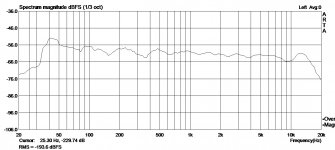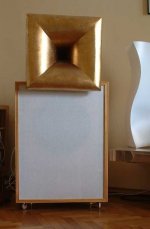Normally that's how I do it too, for safety reasons. But I have to admit I'm living dangerously right now with a direct connection to the compression drivers. A "woopsie" could cost me $250. But it's a tiny tube amp with low gain. Low voltage out and a transformer are giving me a false sense of security.(But I would never connect and amp directly into a compression driver for safety reasons.
90
90
Hi Pos - thanks for the thorough answer. Some thoughts.
Yes, that's true I suppose. But might that damage a tube amp? An impedance so high it looks like an open circuit?The "impedance curve magnifying" thing is not a problem if you consider it is just multiplied: the load variation is still the same for the poweramp.
Sure, you can design the passive crossover for the impedance seen at primary of the step down transformer. OK if you never change it - but what if you change the attenuation? Then the impedance can change significantly, thus changing the frequency response. That's why we use L-Pads. They are somewhat constant impedance.and this is exactly the same situation (with bigger absolute impedance variation for the higher load). This does not change the way the passive filter will act.
In may cases yes, but not always. Maybe OK for some transistors, but output tubes often have ideal operating points. Change that by a lot and you can change the sound.- higher load for the poweramp, which means less distortion
Not sure I understand that. For a given driver voltage and attenuation, the amp has to have the same output voltage for either L-Pad or Transfo. Or am I missing something.- the high load will let an AB poweramp work in class A for the same amount of Watt (received by the driver) than it would have without the autoformer, whereas it would not be the case with an lpad
Some claim lower damping is advantageous for compression drivers. I really don't know, but have often found that series resistance makes then sound better. That could be for entirely different reasons, tho.- more damping for the compression driver, which could not bring any audible gain
I have several of those, including from Parts Express. They are not pretty when measured.Even a cheap autoformer (like the ones found in parts-express inwall volume control) can be good enough for HF duties (with a bit of EQ up high...)
If I had some money to throw at it, I'd have Bud Purvine wind a pair with 3 or 4 taps for me. It would be interesting to hear if there is any difference vs a resistive divider.
Yeah. If the recordings are produced with the best equipment available today right through to the reproduction at the venue it can be fabulous. And digital is so convenient. Problem is where audio designers go mad with device complexity, and numbers that what the digital can produce is noticeably inferior. Studio engineers have perhaps too much scope to add devices like mixers and all the other paraphernalia, with all the mixing and manipulating the recording, it only makes it worse. This is the norm.
Absolute equalisation is not really necessary as some recording are themselves poorly balanced.
Any uncompressed 24/96 format like FLAC ALAC or even 16/44.1 can do great sound as you infer. But MP3 irritates me but some of that may be down to poor recording.
Hard to beat a guitar or other live instrument played directly through a good analogue system. i.e no recording chain.
Vinyl can be good but my revealing analogue SS reproduction system is showing serious defects in many old record pressings. Only some exceptional vinyl cuts it, and that was proven true in the days of Koetsu phono cartridges.
I was transferring some recordings from tape to digital files and noticed recordings did not have the same polarity which tells me that mics can have different polarity as I have noticed in doing measurements. Does this make a difference? Well, my experience was quite interesting.
When the speaker driver performance was not ideal, polarity difference can be heard, but there was no clear indication which was correct. As the driver was tuned to better performance, there was a clear preference depending mostly on which brand of music content was being played. Then as development of the Exaltation commenced and work on it's amplifier commenced, the better the amplifier got, the less polarity difference made although the difference and preference could be detected.
I once asked the question in a mic builders forum how they determined the polarity of the mic they used in a recording, seems like there are standards but no guarantee they are followed, and most were not aware this was a problem.
Since we have no control of the process of music creation through publishing, the only thing we can do is be diligent and cautious consumers when choosing music.
I was transferring some recordings from tape to digital files and noticed recordings did not have the same polarity which tells me that mics can have different polarity as I have noticed in doing measurements. Does this make a difference? Well, my experience was quite interesting.
When the speaker driver performance was not ideal, polarity difference can be heard, but there was no clear indication which was correct. As the driver was tuned to better performance, there was a clear preference depending mostly on which brand of music content was being played. Then as development of the Exaltation commenced and work on it's amplifier commenced, the better the amplifier got, the less polarity difference made although the difference and preference could be detected.
I once asked the question in a mic builders forum how they determined the polarity of the mic they used in a recording, seems like there are standards but no guarantee they are followed, and most were not aware this was a problem.
Since we have no control of the process of music creation through publishing, the only thing we can do is be diligent and cautious consumers when choosing music.
This is what I would expect. Unless the studio engineers are really diligent they will not worry about polarity, especially if they are denyers.
Trouble is you will end up with a mishmash for a whole bundle of mikes more likely on a mix of polarities. So nothing you can do here. With more transparent reproducers it can sometimes matter less because there is so much presence already. Guys like us often have polarity switches ans many frequency analysers are sold with a CD giving a range of tests as you know and include a polariy checker. Very useful and time saving. If the recording is in the same polarity for say an orchestra the music will feel fuller in the mids and bass.
That makes sense. The usefulness of more bit depth is an entirely different discussion for recording and production than for playback of the final product.A friend of mine whom used to be into recording felt bit depth made the most difference.
Ultimately, everything is digital, thus says quantum mechanics.I do agree you have to start from something simple, but when you want to improve in it, you either have to improve the component, use it in a smaller operation range, or design something to improve on it. From what I can tell, there is nothing wrong with the digital format as long as you increase the bit depth and sample rate. The main problem is proper design and layout of the circuits because the digital circuits do have some negative effects on the analog sector. The power supply is also important.
Then it is just a matter of bit depth and sample rate.
nope.Darn, I thought it was all strings....
Too easy to get tangled.
Hands up all those who have not lived "dangerously" at some stage with audio gear!Normally that's how I do it too, for safety reasons. But I have to admit I'm living dangerously right now with a direct connection to the compression drivers. A "woopsie" could cost me $250.
Hmmm ... I thought so ...
x-over ?
That's quite impressive. What do you use for a crossover ?
My 2 way Altec based loudspeaker (416-8c in 180 lit. BR + 288-8k on 400Hz JMLC horn); both channels measured at listening position (average of 10 measurements 1m2 around listening seat).
That's quite impressive. What do you use for a crossover ?
room photograph
Hi there V: Fabulous speakers, nice sculpture too. ...regards, Michael
My 2 way Altec based loudspeaker (416-8c in 180 lit. BR + 288-8k on 400Hz JMLC horn); both channels measured at listening position (average of 10 measurements 1m2 around listening seat).
Hi there V: Fabulous speakers, nice sculpture too. ...regards, Michael
That very gradual drop of frequency response is really hard to fine tune.My 2 way Altec based loudspeaker (416-8c in 180 lit. BR + 288-8k on 400Hz JMLC horn); both channels measured at listening position (average of 10 measurements 1m2 around listening seat).
Vuki,
Why no conjugate network on the bass speaker, only on the cd?
It's there just to attenuate mild upper midrange hump.
Normally that's how I do it too, for safety reasons. But I have to admit I'm living dangerously right now with a direct connection to the compression drivers. A "woopsie" could cost me $250.
Damn, same here, except that it will cost me many times higher. May be its time to look (again) at protection projects. Dedicated small transformer on a portable protection board.
Sorry, must disagree with the bit depth and sample rate thing. Redbook standard is fine, is capable of superbly good sound - digital falls down because of poor implementation of the playback electronics, as in some of the things you mentioned. Get everything right, then digital needs no excuses, whatsoever ...
If it was "fine", studios would use it for mastering. There is a reason they don't.
- Home
- Loudspeakers
- Multi-Way
- Beyond the Ariel


